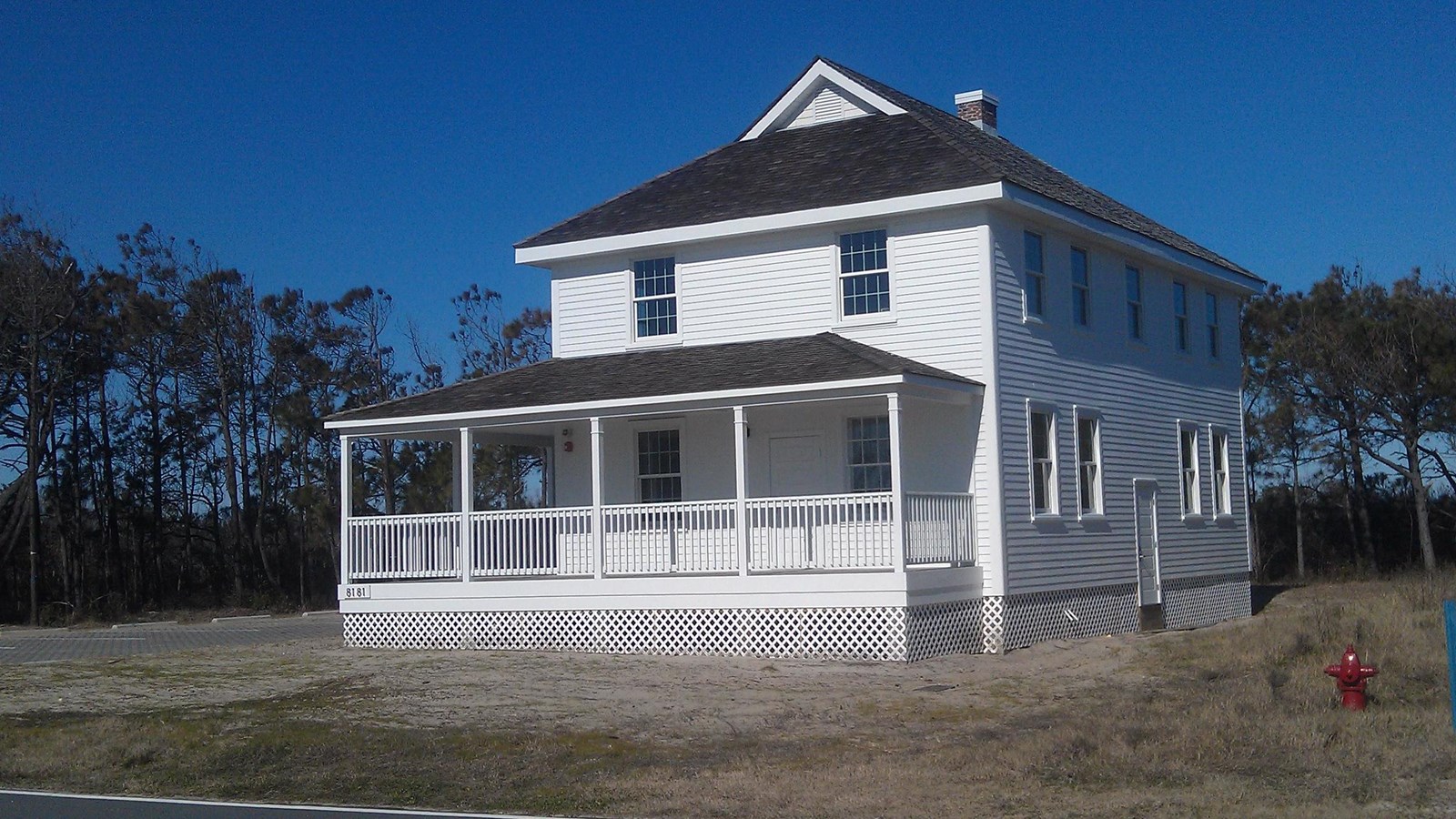Last updated: May 12, 2023
Place
Bodie Island Life Saving Stations

Historical/Interpretive Information/Exhibits, Scenic View/Photo Spot
The Bodie Island Life-Saving Station (BILSS), one of two ife saving stations preserved at Cape Hatteras National Seashore, has an amusing, if not somewhat confusing story for its origin. The confusion exists on multiple levels. It starts by the improbable naming of the inlet. When a gigantic hurricane ripped open a huge void between Bodie Island to the north and Pea Island to the south on September 7, 1846, a nearby sailing vessel named Oregon was nearly wrecked by the storm and so passed through the new inlet to seek safety out of the Ocean. The inlet quickly became known locally as the Oregon Inlet, while the more logical name would be “the Bodie Inlet,” much like “Hatteras Inlet” is named from the gap between Hatteras and Ocracoke, and “Ocracoke Inlet” is named for the water between Ocracoke Island and Portsmouth Banks.
The confusion began in earnest with the naming of the first station south of Oregon Inlet. It was one of the first seven of 1874-style, but somehow it was named as the Bodie Island U.S. Life-Saving Station No.16 even though it was clearly not on Bodie Island, but rather Pea Island (or the northern end of Hatteras Island). The first keeper of this station was Edward Drinkwater.
In the next round of construction in 1878, one of the eleven 1876-type stations was built a mile and one-eighth north of the 1872 Bodie Island Lighthouse and named Tommy’s Hummock (Hummock is a rounded knoll or small hill frequently made from the shifting winds of the Outer Banks).
In 1883, the mis-naming was corrected by renaming Tommy’s Hummock as the Bodie Island station. That meant that the ‘old’ 1874 Bodie Island station still on the south side of the inlet had to be renamed and so became the Oregon Inlet station.
Dating this structure can also be confusing. The “blueprint plans” were dated 1876, so this is called “an 1876-type.” But it was built in 1878 and finished in December of that year. Some, some say it is an 1878 station. However, it was not commissioned, occupied and active until the next month, January 1879 – so, that is the official date.
Significant Dates in Its History
1879: Jan. 15-16, Keeper Jessie T. Etheridge and crew mans United States Life-Saving Service Station Bodie Island No. 14, District 6.
1900: Enclosed watch tower added to main building.
1899: San Ciriaco hurricane causes great structural damage to station and Hatteras Island.
1914: Oct. 28, Keeper P.H. Etheridge (who we must assume is “Patrick Henry” Etheridge, former keeper of Cape Hatteras and Creeds Hill), becomes keeper the day United States Life-Saving Service is renamed the United States Coast Guard. Apr. 9, Robert L. Wescott becomes acting Keeper.
1925: July 16-17, crew moves into new station adjacent.
1933: Infamous hurricane of Sept. 1933 hits area hard.
1937: July 15, Bodie Island Station(s) decommissioned. Property vacant.
1944: During WWII, old 1879 Station building used as galley and mess hall.
1953: Oct. 15, BILSS complex deeded to National Park Service.
1955: Stations relocated first time, still on beach. Serves as park headquarters until mid 1960s.
1988: 1925 Station used by Coast Guard personnel as barracks while their new Oregon Inlet station was being built.
1991: 1879 Station gutted and remodeled as a modern building for staff quarters.
2013: 1879 and 1925 Stations relocated second time to current site at entrance of Bodie Island Lighthouse.
Wreck & Rescues
Every station had hundreds of incidents in its service history, but most were small. If a major wreck and rescue occurred, the Service included a detailed report every year in their Annual Report. What follows is the verbatim (including original spelling and grammar) report of Keeper Jessie Etheridge of the Bodie Island Life-Saving Station, from the Annual Report of the Operations of the United States Life-Saving Service for the fiscal year ending June 30, 1894:
Schooner Florence C. Magee ~ 25 February 1894
Stranded and sunk on the evening of the 25th instant. Called Nags Head crew by telephone, and went to her with beach apparatus about 1 a.m. Crew of 10 persons were in the rigging. Tried to use the beach gear, but although three shot lines were placed on board, the swift current prevented the successful working of the apparatus. Finally launched the surfboat, the keeper of the Nags Head Station accompanying the Bodie Island crew. At about the same time a fishing smack ran down the beach outside the breakers and had taken off four of the crew when the surfboat reached the schooner. The life savers took off the remaining 6 persons and received into the surfboat the four men who had got into the smack. Landed them safely, and succored them two days at the station and provided clothing. The captain remained at the station 9 days.
Compiled and written by James D. Charlet.
